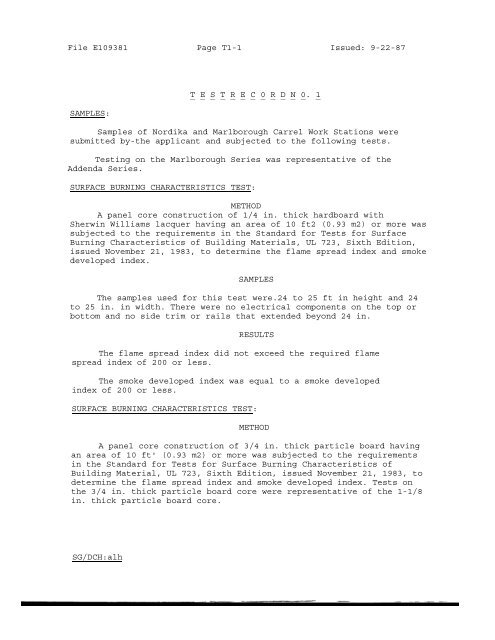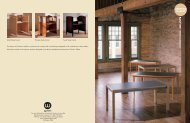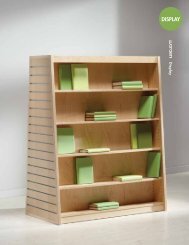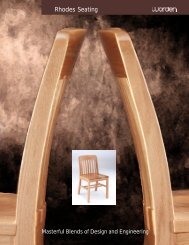File E109381 Page T1-1 Issued: 9-22-87 T E S T R E C 0 ... - Worden
File E109381 Page T1-1 Issued: 9-22-87 T E S T R E C 0 ... - Worden
File E109381 Page T1-1 Issued: 9-22-87 T E S T R E C 0 ... - Worden
You also want an ePaper? Increase the reach of your titles
YUMPU automatically turns print PDFs into web optimized ePapers that Google loves.
<strong>File</strong> <strong>E109381</strong> <strong>Page</strong> <strong>T1</strong>-1 <strong>Issued</strong>: 9-<strong>22</strong>-<strong>87</strong>SAMPLES:T E S T R E C 0 R D N 0. 1Samples of Nordika and Marlborough Carrel Work Stations weresubmitted by-the applicant and subjected to the following tests.Testing on the Marlborough Series was representative of theAddenda Series.SURFACE BURNING CHARACTERISTICS TEST:METHODA panel core construction of 1/4 in. thick hardboard withSherwin Williams lacquer having an area of 10 ft2 (0.93 m2) or more wassubjected to the requirements in the Standard for Tests for SurfaceBurning Characteristics of Building Materials, UL 723, Sixth Edition,issued November 21, 1983, to determine the flame spread index and smokedeveloped index.SAMPLESThe samples used for this test were.24 to 25 ft in height and 24to 25 in. in width. There were no electrical components on the top orbottom and no side trim or rails that extended beyond 24 in.RESULTSThe flame spread index did not exceed the required flamespread index of 200 or less.The smoke developed index was equal to a smoke developedindex of 200 or less.SURFACE BURNING CHARACTERISTICS TEST:METHODA panel core construction of 3/4 in. thick particle board havingan area of 10 ft' (0.93 m2) or more was subjected to the requirementsin the Standard for Tests for Surface Burning Characteristics ofBuilding Material, UL 723, Sixth Edition, issued November 21, 1983, todetermine the flame spread index and smoke developed index. Tests onthe 3/4 in. thick particle board core were representative of the 1-1/8in. thick particle board core.SG/DCH:alh
<strong>File</strong> <strong>E109381</strong> <strong>Page</strong> <strong>T1</strong>-2 <strong>Issued</strong>: 9-<strong>22</strong>-<strong>87</strong>SAMPLESThe samples used for this test were 24 to 25 ft in height and24 to 25 in. in width. There were no electrical components on the topor bottom and no side trim or rails that extended beyond 24 in.RESULTSThe flame spread index did not exceed the required flamespread index of 200 of less.The smoke developed. index was equal to a smoke developedindex of 200 or less.SURFACE BURNING CHARACTERISTICS TEST:METHODA panel core construction of 3/4 in. thick Aspen wood with MobilDuratuff lacquer having an area of 10 ft2 (0.93 m2) or more wassubjected to the requirements in the Standard for tests for SurfaceBurning Characteristics of Building Materials, UL 723, Sixth Edition,issued November 21, 1983, to determine the flame spread index and smokedeveloped index. This test was representative of 1/4 in. to 1-3/4 in.thick Aspen wood cores.SAMPLESThe samples used for this test were 24 to 25 ft in height and24 to 25 in. in width. There were no electrical components on the topor bottom and no side trim or rails that extended beyond 24 in.RESULTSThe flame spread index did not exceed the required flamespread index of 200 or-less.The smoke developed index was equal to a smoke developedindex of 200 or less.SG/DCH:alhPC lbry
<strong>File</strong> <strong>E109381</strong> <strong>Page</strong> <strong>T1</strong>-4 <strong>Issued</strong>: 9-<strong>22</strong>-<strong>87</strong>SHELF LOADING TEST:METHODThe largest shelf supplied by the manufacturer was assembled ontothe Marlborough Carrel work station. Each shelf less than 8 in. (203mm) deep was subjected to a load equal to the width of the shelf ininches times 3.0 lb (1.4 kg). Each shelf more than 8 in. but not morethan 16 in. (406 mm) deep was subjected to a load equal to the width ofthe shelf in inches times 5.0 lb (2.3 kg). Each shelf more than 16 in.deep was subjected to a load equal to the width of the shelf in inchestimes 7.0 lb (3.2 kg). Each load was uniformly applied along the entirewidth of the shelf, centered on a line at the mid depth of the shelf or4-1/4 in. (108 mm) in from the most extended edge of the shelf,whichever was farthest from the back edge. The load was graduallyincreased from zero to the specified value and maintained for 5 min.RESULTSShelf System Cat. No. Depth, in. Weight, lbMarlborough 10 300The component did not collapse or deform to a degree thatpresented a risk of injury to persons or presented a risk of fire orelectric shock. The supporting wall did not collapse or deform to adegree that presented a risk of injury to persons or to such a degreethat components were damaged or electrical spacings were reduced belowminimum acceptable levels.SG/DCH:alhPC lbry
<strong>File</strong> <strong>E109381</strong> *<strong>Page</strong> T2-1 <strong>Issued</strong>: 9-<strong>22</strong>-<strong>87</strong>New: 10-20-<strong>87</strong>SAMPLES:T E S T R E C 0 R D N O. 2Samples of an alternate core construction were submitted by theapplicant and subjected to the following tests.The alternate construction was the 3-ply particle board with thelaminate surfaces secured to the particle board with contact adhesive.Three sets of panels were tested using the followingadhesives by H. B. Fuller.Test No. 1: Type SC-1940Test No. 2: Type SC-1913Test No. 3: Type SC-1969SURFACE BURNING CHARACTERISTICS TEST:METHODA panel core construction having an area of 10 ft' (0.93 m2) ormore was subjected to the requirements in the Standard for Tests forSurface Burning Characteristics of Building Materials, UL 723, SixthEdition, issued November 21, 1983, to determine the flame spread indexand smoke developed index.SAMPLESThe samples used in each set for this test were 24 to 25 ft inheight and 24 to 25 in. in width. There were no electrical components onthe top or bottom and no side trim or rails that extended beyond 24 in.RESULTSIn each case the flame spread index did not exceed therequired flame spread index of 200 or less.In each case the smoke developed index was equal to a smokedeveloped index of 200 or less.SG/DCH:alhPC lbry:cb
<strong>File</strong> <strong>E109381</strong> *<strong>Page</strong> T3-1 <strong>Issued</strong>: 9-<strong>22</strong>-<strong>87</strong>New: 9-9-88T E S T R E C O R D N O. 3SAMPLE:A sample of the 106 in. work surface was submitted by themanufacturer. It was found to be constructed as described in Fig. 1 ofthis Report.Due to a divider, used for support, supplied every 3 ft, no testswere considered necessary.KJH/SAS:alhPC Lbry:wj
<strong>File</strong> <strong>E109381</strong> *<strong>Page</strong> T4-1 <strong>Issued</strong>: 9-<strong>22</strong>-<strong>87</strong>New: 4-28-89T E S T R E C O R D N O. 4No tests were considered necessary on base power entry, Cat. Nos.PPS or IES, followed by 24, 27, 29, 36 or 39, followed by PE-1, PE-1G,PE-2, PE-3, or PE-3G; wall power entry, Cat. Nos. PPS or IES, followedby 12-4, 12-5, or 12-6, followed by WE, followed by 1, 1G, 2, 3, or 3G;New York City power floor entry, Cat. Nos. NYC, followed by 24 through39, followed by PE, followed by 3G; New York City power leg entry, Cat.Nos. NYC, followed by 24 through 39, followed by PL or PLQ, followed by3G; New York City wall power entry, Cat. Nos. NYC, followed by 12-6,followed by WE or WEB, followed by 3G, due to similarities and testsperformed on the same catalog numbers.1-3.See the Report dated September 23, 19<strong>87</strong>, Test Record Nos.PE/SAS:alh.PC Lbry:eg
<strong>File</strong> <strong>E109381</strong> *<strong>Page</strong> T6-1 of 3 <strong>Issued</strong>: 9-<strong>22</strong>-<strong>87</strong>New: 12-19-91SAMPLES:T E S T R E C O R D N O. 6Samples of the 8-wire PPS electrical system were submitted bythe manufacturer and subjected to the following tests.These samples employed manufactured by The Byrne ElectricalSpecialists 8-wire electrical components.Only limited tests were conducted on these assemblies because ofsimilarities and tests performed on the 4 and 6-wire assembliescovered in this Report dated September 23, 19<strong>87</strong>.GROUNDING IMPEDANCE TEST:METHODTwo samples of 8-wire electrical assemblies, Cat. No. PPS/29/PL-1and Cat. No. PPS/12-6-8/J41 were electrically and mechanically connectedas intended. An alternating current of 25 A derived from a source withan open circuit voltage not exceeding 6 V was passed between thegrounding pin of Cat. No. PPS/25/PL-1 and any point on the adjacentraceway. The closed circuit voltage (CCV) was then measured betweenthese two points and the impedance calculated. The procedure wasrepeated a minimum of three times, each time the point or points ofsupply connections were changes. The grounding path was allowed to coolbetween each test.RESULTSCalculatedLocation CCV Impedance ohm1. The leg of PPS/29/PL-1 near .23 0.009cord entry2. By the conduit connector on .23 0.009Cat. No. PPS/29/L-13. Conduit on Cat. No. PPS/12-6-8/ .67 0.027J41The maximum impedance was not more than 0.1 ohms.TRL/MJW:alhPC Lbry pjw
<strong>File</strong> <strong>E109381</strong> *<strong>Page</strong> T7-1 of 1 <strong>Issued</strong>: 9-<strong>22</strong>-<strong>87</strong>Revised: 6-29-93T E S T R E C 0 R D N O. 7No tests were considered necessary on the Panel End Series CarrelWork Stations or the Post and Panel Carrel Work Stations. Only theseries name has changed. The Panel End Series is the former Addenda andMarlborough Series. The Post and Panel Series is the former Nordika and<strong>22</strong>00 Series.TRL/BCR:alhPC Lbry:slo
<strong>File</strong> <strong>E109381</strong> *<strong>Page</strong> T8-1 of 1 <strong>Issued</strong>: 9-<strong>22</strong>-<strong>87</strong>New: 6-29-93T E S T R E C 0 R D N 0. 8No tests were considered necessary on Cat. No. Cable Chase dueto the trial installation test performed on the Cat. No. Cable Chasewith the electrical accessories. See Report dated September 23, 19<strong>87</strong>,Test Record No. 9.TRL/BCR:alhPC Lbry:slo






